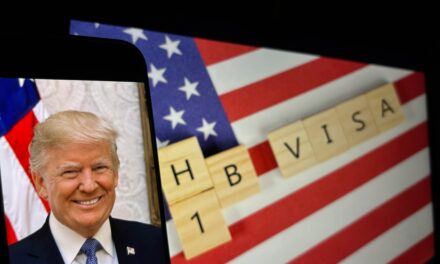“Now what?”
That was the market’s response following the Federal Reserve’s interest rate cut on Wednesday — the highly-anticipated first cut of 2025.
As it turns out, the rate cut was already priced in.
And by opting to cut the benchmark rate by just a quarter-point and no more, Jerome Powell is sending a pretty clear signal of what we can expect in the months ahead. And it’s not good news.
Hit the video link below to get started:
Video transcript:
This is Moneyball Economics. I’m Andrew Zatlin, and we can finally talk interest rate cuts.
This week, the Fed has cut rates by 25 basis points.
What does that signify and what comes next? Well, that’s what we’re going to talk about.
First of all, the market yawned when they saw the 25 basis point cut. It was already priced in and it was priced in for very important reason. We’re kind of late to the party, and I say that not because of the economics of it all. I say that because of what’s happening with our trading partners.
You see, our trading partners have been cutting their interest rates. When the US doesn’t move in lockstep with other central banks, we have a relative value situation going on if our trading partners are cutting their interest rates and we are not. Effectively speaking, we’ve raised our interest rates, so that makes the dollar more valuable and leads to some downstream problems.
By cutting interest rates even 25 basis points, all the Fed is doing is treading water, basically saying to them, “you cut your rates, okay, we’ll cut ours.” So it really doesn’t have anything to do with economics.
The other reason the market yawned was because practically speaking, 25 basis points isn’t really meaningful. It’s a gesture. See, people aren’t going to suddenly rush out, refinance their mortgages to lock in that 25 basis point drop.
Companies at this time of year, they’re starting to fold up tents and wind things down for end of the year. They’re not really looking at launching new capital spending plans and 25 basis points. That’s not really going to move the dial that much for them. Even more critically off on the side, the Fed’s kind of repeating last year where they kind of triggered a slowdown because in the commentary that followed the rate cut, they mentioned that they are inclined to do more rate cuts this year as many as two.
So imagine you’re the CFO of a company.
You could look at your CapEx spending and you could borrow to do something. After all, they just handed you lower cost of borrowing 25 basis points, or you could wait two or three months and you’ll get an additional 50 basis points for some total of 75 basis points. Now that’s exciting, that’s intriguing, and that’s going to make me the CFO want to wait and see.
So that means that a lot of the spending that was planned probably going to get pushed out to January.
We have basically created an economic slowdown. Way to go Fed! So it’s 25 basis points. It doesn’t mean anything.
It is however, a gesture to Trump who’s been wanting 50 basis points. It’s a gesture to Trump and the rest of the world that the central bank is an independent outfit that yes, they acknowledge that summary rate cuts necessary, but they’re not going to kowtow to the president.
Okay, let’s move along 25 basis points, another 50 coming down the pipeline.
What is the Fed thinking? Because I think they are making a practical mistake in the way that academics tend to make mistakes where they basically don’t understand the real world.
What the Fed is trying to balance is a concern of economic slowdown on the one hand, inflation on the other. For economic slowdown, pretty obvious we’ve had nothing but bad jobs reports since April. Manufacturing all these other data points. Slow, slow, slow … indicating that through the rest of the year it’s going to be slow, slow, slow.
Now the Fed tends to be backwards looking, meaning nice way to say that as they like to say it, euphemistically “data-driven.” So they’re not very forward-looking. They don’t really anticipate what’s going on all. Yeah, we know the economy’s slowing, it’s going to continue to slow.
Meanwhile, inflation is not really falling as much as they’d like.
Inflation year over year is still 3.1% and there’s this fear that tariffs are going to keep it sticky at that level. Here’s the mistake. So the Fed wants to do a little bit 25 basis points, go the economy a little bit, tease some more, get people motivated.
The problem is, A, it’s not really going to do anything for the economy. B, they’re never going to reach their inflation target without a recession. Let me explain. If you look at the components of inflation and inflation at 3.1%, the biggest chunk of keeping it there is essentially the housing market shelter is one third roughly of the total CPI calculation and it’s holding at about 3.6%.
So it’s kind of anchoring that number up, but there are other factors that come into play. You can raise or keep interest rates high and eventually that should lead to problems in the housing market, which it has, and it should lead to that shelter number coming down.
It hasn’t, but it should. Where the problem is that another big chunk, roughly 10 to 15% of what’s driving up inflation, driving it up, we’re talking four to 5% inflation rate.
What’s pushing it up are things that are not sensitive to inflation. I mean things like insurance, auto insurance, home insurance…
Right now, the insurance industry has to recover from things like the Pacific Palisades buyer last year, which is going to cost them $50 billion. They’ve got problems in Florida where a lot of those condo towers are sinking into the ocean.
You’re not going to make insurance premiums come down simply because you’ve raised interest rates. Think of healthcare. Healthcare is about 7% of the CPI calculation, and it just keeps going up and up and up. Why? Because it’s a tax. We are forced to buy auto insurance, we’re forced to buy home insurance. You’re forced to buy health insurance.
These things are insensitive to interest rates. And so what that means is if you are going to offset these items that are going to move up no matter what, the only mathematical way we will ever see the inflation target come down from 3.1%. See the target of 2% is if we have an outright recession, if all the other components turn negative and they turn negative when you’ve got a recession. So in essence, the Fed is sitting here saying, we want what we can never have.
We want to stimulate the economy and avoid a recession, but we are never going to get interest rates low without a recession.
So what do you do? So they’re kicking the can. They’re waiting and seeing, waiting and seeing and waiting and seeing. And what is going to happen is come January, you’re going to see Donald Trump move to stack the deck against the hawks who are on the board who want to keep interest rates high.
And he’s basically going to say, I don’t care about inflation. I care about the economy. I care about a slowdown and you are going to move faster. And that’s the bet I’m making is that the Fed is going to make a colossal mistake.
They’re going to be late to the party again because it’s just going to be impossible for them to understand that interest rates are not going to meet their target. So either they change their target or they come off of it a little bit and say, well, we’re close enough.
So if for example, the economy does slow down, even bringing the inflation rate from on CPI from 3.1% to 2.9% might give them the ground cover, but by and large, we’re going to see two more interest rate cuts this year and I think they’re going to follow on with a few more.
Now, the wild card here is if Trump throws a tariff dividend out there on the table, which would stimulate the economy again and kind of reverse whatever slow down inflation is out there, that’s scaring the fed.
But by and large, we’re now firmly on a trajectory of more rate cuts, but it comes with having a weakening economy. I like banks right now. I like banks because ultimately in a couple of months, give us a couple more rate cuts. People are going to refinance, companies are going to borrow more and credit card spending’s going to go up. Bottom line, banks are in a great situation.
We are in it to win it, folks.
Zatlin out.

Andrew Zatlin
Editor, Moneyball Economics





